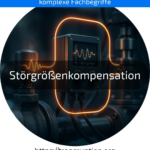The term disturbance compensation originates from the fields of automation, industry and Factory 4.0 as well as the Internet of Things. In these fields, the aim is to control machines and processes as efficiently and precisely as possible.
Disturbance variables are influences that can disrupt a production process. These can be, for example, temperature fluctuations, vibrations or other external influences that result in a product not being manufactured as desired.
Disturbance compensation is a method used to compensate for such disturbances. Sensors continuously measure the current values and intelligent systems adjust the machine controls so that the end result is still correct.
One example: A robot produces car parts in a factory. Suddenly, the room temperature fluctuates significantly, which can affect the dimensions of the components. With disturbance compensation, the control system recognises the temperature fluctuation and reacts immediately by slightly adjusting the robot's movements. In this way, the car parts always remain in the desired dimensions - despite external disturbances.
Disturbance compensation therefore helps to ensure production quality and reliability and is therefore an important part of modern manufacturing processes.






